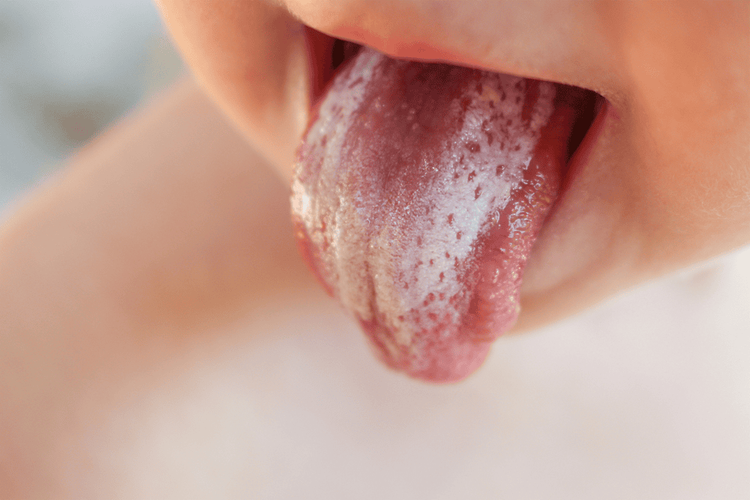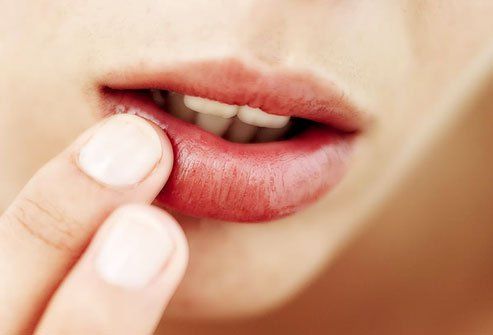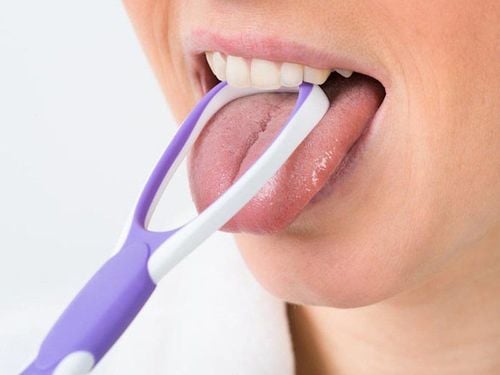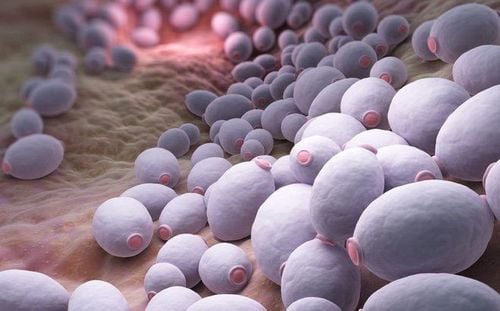This is an automatically translated article.
Oral thrush causes white or yellow bumps due to a yeast infection in the mouth. This condition, which is common in infants and toddlers, is also known as oral candida or thrush. Infections are usually mild and rarely cause serious problems. However, the bumps also disappear with treatment.
1. Symptoms of oral thrush
In the early stages, thrush may not show any symptoms. But as the infection gets worse, one or more of the following symptoms may appear:
Creamy white or yellow (cheese-like) patches inside the cheeks, thrush on the tongue, tonsils, gums, or lips. Slight bleeding from the bump if rubbed or scraped Soreness or burning in the mouth, making it difficult to eat or swallow Feeling of dry mouth Dry, cracked skin at the corners of the mouth Difficulty swallowing An unpleasant odor in the mouth Loss of taste A yeast infection in the baby's mouth also makes it difficult to suckle, making the baby uncomfortable or fussy. In some cases, oral thrush can affect the esophagus, but is uncommon. If present, thrush spreading into the esophagus will cause:
Pain when swallowing or difficulty swallowing Feeling of food getting stuck in the throat or in the center of the chest Fever (if the infection has spread beyond the esophagus) Breastfed babies Oral thrush can be transmitted to the breast and cause:
Red, sensitive, cracked or itchy nipples Glossy or flaky skin on the areolas Nipple pain between feedings The same fungus that causes thrush can also cause thrush. make a yeast infection, enter the bloodstream, and spread to the heart, brain, eyes, or other parts of the body (invasive or systemic candidiasis). In people with weakened immune systems, oral thrush can easily spread to many places and lead to potentially serious complications. Systemic candidiasis can cause septic shock, which is life-threatening.

Nấm miệng ở trẻ khiến bé khó chịu hoặc quấy khóc.
2. Causes of oral thrush
Oral thrush and other yeast infections are caused by an overgrowth of the fungus Candida albicans (C. albicans). Normally, a small amount of C. albicans stays in your mouth without causing harm. When the immune system is working properly, beneficial bacteria in the body help control C. albicans. But if the immune system is compromised or there's an imbalance of microorganisms in the body, fungus can grow out of control.
The cause of C. albicans overgrowth that causes oral thrush is likely due to taking certain medications, which reduce the number of beneficial microorganisms in the body, such as antibiotics. Cancer treatments, including chemotherapy and radiation, also damage or kill healthy cells. This makes you more susceptible to thrush and other infections. Conditions that weaken the immune system, such as leukemia and HIV, also increase the risk of developing thrush. Oral thrush is a common infection in people with HIV. In addition, diabetes contributes to the development of oral thrush. Poorly controlled diabetes weakens the immune system and causes high blood sugar. This creates favorable conditions for the fungus C. albicans to grow. You are also at higher risk for thrush if:
Frequent dry mouth Anemia Taking corticosteroids or immunosuppressants Smoking Smoking wearing dentures
3. Is a fungal infection in the mouth contagious?
People with thrush can spread the fungus to others through direct contact, eg kissing. The fungus that causes thrush also causes yeast infections in other body parts. Therefore, the routes of transmission are also very diverse.

Nấm miệng có thể lây truyền cho người khác qua tiếp xúc trực tiếp.
Oral thrush , vaginal yeast infection or penile yeast can be passed on to a sexual partner through sexual contact, including anal or oral sex. Pregnant women with vaginal yeast infections are at risk of passing the fungus to their babies during delivery. Women with a yeast infection of the breast will pass the fungus on to their baby while breastfeeding. Conversely, babies with oral thrush can also pass the fungus on to their mothers while breastfeeding.
Also, because C. albicans is so common in the environment, if you have oral thrush it doesn't have to be from other people.
4. Methods of treating oral thrush
The doctor can diagnose oral thrush by examining the patient's mouth for characteristic signs. In some cases, your doctor will biopsy the affected area for confirmation. You'll have a small scrap of a bump from your mouth, and then send the sample to a lab to look for C. albicans.
Oral thrush is easy to treat in children and healthy adults, but people with weakened immune systems are more complicated. To treat thrush, your doctor usually prescribes one or more of the following medicines for 10-14 days:
Antifungal medicine fluconazole (Diflucan) Antifungal lozenges clotrimazole (Mycelex Troche) Antifungal mouthwash nystatin (Nystop, Nyata), a cotton swab can be dipped into the mouth of young children Oral antifungal itraconazole (Sporanox), indicated for people who have not responded to other treatments and people with HIV Oral medications severe fungal infection amphotericin B (AmBisome, Fungizone) Thrush usually clears up after a few weeks of treatment, but in some cases it can recur. For adults with recurrent oral thrush of unknown cause, the doctor will evaluate for underlying medical conditions contributing to oral thrush.
Newborns may experience several episodes of thrush during the first year of life. If you are breastfeeding and have a fungal infection, use pads to prevent it from spreading to your clothes. You also need to change into a clean bra every day, and ask your doctor how to clean nipples, pacifiers, and pump parts. A doctor should be consulted before giving any supplement to an infant.
5. Home Remedies
Your doctor may also recommend home remedies or lifestyle changes to treat thrush and prevent it from coming back. After recovery, it is important to have good oral hygiene. A few other helpful tips include:Brush your teeth with a soft brush to avoid hurting the fungal swelling Change your toothbrush after completing the treatment If you wear dentures, it needs to be cleaned properly to reduce the risk of re-infection Avoid overuse, arbitrarily use mouthwash or mouth spray if not prescribed by your doctor

Súc miệng nước muối đúng cách giúp giảm chứng nấm miệng.
Salt water A solution of water and baking soda Mixture of water and lemon A mixture of water and apple cider vinegar Yogurt with probiotics or probiotic supplements is also a good choice. On the other hand, limiting or avoiding certain foods, such as refined carbohydrates and sugar, can inhibit the growth of C. albicans, helping to treat or prevent thrush and other types of yeast infections.
The goal of all oral thrush treatments is to stop the rapid spread of Candida. However, choosing the best method depends on your age, overall health, and the cause of the infection. Controlling and treating underlying causes and chronic health problems can also prevent oral thrush from recurring.
To examine and treat dental problems, you can go to the Department of Odonto-Stomatology - Vinmec International General Hospital. Currently, Vinmec is one of the leading prestigious hospitals in the country, trusted by a large number of patients for medical examination and treatment. Not only the physical system, modern equipment: 6 ultrasound rooms, 4 DR X-ray rooms (1 full-axis machine, 1 light machine, 1 general machine and 1 mammography machine) , 2 DR portable X-ray machines, 2 multi-row CT scanner rooms (1 128 rows and 1 16 arrays), 2 Magnetic resonance imaging rooms (1 3 Tesla and 1 1.5 Tesla), 1 room for 2 levels of interventional angiography and 1 room to measure bone mineral density.... Vinmec is also the place where a team of experienced doctors and nurses will gather a lot of support in diagnosis and detection. early signs of abnormality in the patient's body. In particular, with a space designed according to 5-star hotel standards, Vinmec ensures to bring the patient the most comfort, friendliness and peace of mind.
Please dial HOTLINE for more information or register for an appointment HERE. Download MyVinmec app to make appointments faster and to manage your bookings easily.
References: mayoclinic.org, healthline.com, webmd.com












